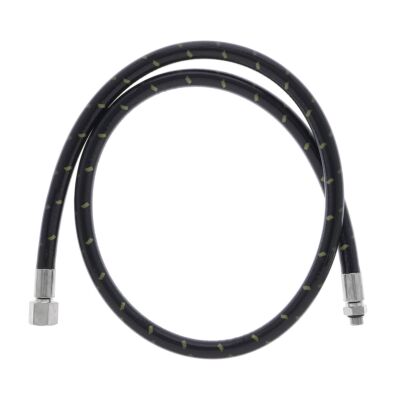Regulator Miflex XT-Tech Hose
- Similar characteristics of traditional rubber hose yet benefits of a braided flex hose
- Smooth polyurethane outer surface reduces abrasion
- Braided layer includes Kevlar® yarn reinforcement
- Negative buoyancy - Lighter in weight than traditional rubber hoses
- Fittings are marine grade nickel plated brass
Regulator Miflex XT-Tech Hose
The multi-layer design of the Miflex XT-Tech hose has a polyether based thermoplastic inner liner, fiber braiding of polyester & Kevlar® and an outer smooth layer of thermoplastic. The Miflex XT-Tech hose is negatively buoyant, allowing the hose when routed behind the neck to stay in place with less abrasion.
- Inner lining is made from polyether based polyurethane
- Braided layer includes Kevlar® yarn reinforcement
- Smooth polyurethane outer surface reduces abrasion around the neck
- Negative buoyancy allow the longer hoses to stay in place
- Lighter in weight than traditional rubber hoses
- Fittings are marine grade electroless nickel plated brass
- 100% leak tested and produced on fully automated assembly lines
MIflex XT-Tech low-pressure regulator hoses are currently available in a limited number of lengths with standard 3/8-inch male first stage and 9/16-inch female second stage fittings. All Miflex hoses are certified to conform to the CE EN250 standard and Nitrox Ready. All Miflex XT-Tech hoses are supplied in re-usable dry bag packaging, complete with manufacturers user and warranty information.
| Brand | XS Scuba |
|---|---|
| SKU | MF-MXTxx |
| Weight | 0.500000 |
Customer Reviews
 WARNING
WARNING
Keep in mind that all hoses will fail sooner or later either due to age, storage conditions or handling. Scuba hoses, regardless of brand and materials, require some minimal care. Do not allow hoses to receive prolonged exposure sunlight, as the heat and UV from strong sunlight will significantly shorten the life of the hose. Do not attempt to flush the inside of the hose with any form of solvent or other chemical, new hoses are factory clean and if you have any reason to think they are no longer clean then the hose should be replaced. Prior to every dive trip you should always pressurize and inspect your hoses for mechanical damage, corroded fittings, bulges and leaks. Dive Gear Express suggests replacing all SCUBA regulator hoses every five years of service or 500 dives, whichever comes first.
Choosing the Best Regulator Hose Length
The most common hose length found on the primary SCUBA regulator is about {28 to 30 in | 71 to 76 cm}. For many divers, this hose is too long and will cause the hose to "bow out," and create unnecessary drag and tug on the mouth. This makes for an uncomfortable dive, particularly in current. Some divers and even manufacturers attempt to improve the situation by making the hose even longer and perhaps adding a 360° swivel - which usually makes the problem even worse. Many of our our experienced divers choose the slightly shorter length of a {26 in | 66 cm} flex hose, feeling it is more comfortable with less drag and pull.
Increasingly we see our experienced single tank divers using a {40 in | 1 m} hose routed under their arm with the primary regulator on 90° swivel and use a shorter {22 in | 56 cm} hose for the backup regulator. The backup regulator is hung on a necklace directly below the chin. The { 40 in | 1 m } hose is also the common choice for the alternate regulator used on traditional sport diving "octopus" configurations. It is the most popular length for technical diving stage and deco regulators as well.
Many advanced divers and instructors believe the common hose lengths are too short in out-of-air situations and now use a much longer hose, often { 60 in | 1.5 m } for those who dive open water exclusively. Technical divers have adopted a length of { 84 in | 2.1 m } for overhead environments.

